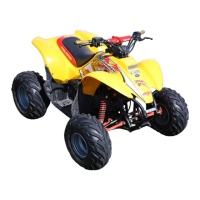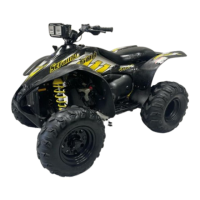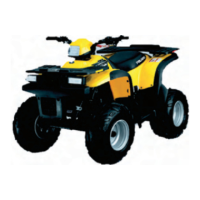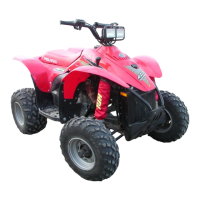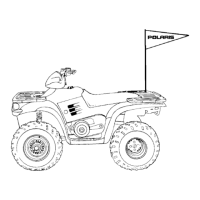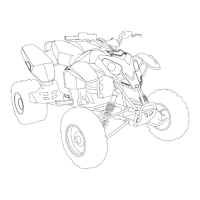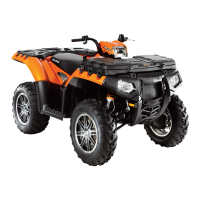ENGINE
2.13
Cylinders may be wet or dry honed depending upon
the hone manufacturer’s recommendations. Wet
honing removes more material faster and leaves a
more distinct pattern in the bore.
HONING TO OVERSIZE
If cylinder wear or damage is excessive, it will be
necessary to oversize the cylinder using a new
oversize piston and rings. This may be accomplished
by either boring the cylinder and then finish honing to
the final bore size, or rough honing followed by finish
honing.
EXAMPLE OF CROSS HATCH PATTERN
For oversize honing, always wet hone using the
specified oil and coarse roughing stones. Measure
the piston (see piston measurement) and rough hone
to the size of the piston. Always leave .002 - .003² (.05
- .07 mm) for finish honing. Refer to piston-to-cylinder
clearance specifications on Page 2.17 before honing.
Complete the sizing with fine grit stones to provide the
proper cross-hatch finish and required piston
clearance.
A finished cylinder should have a cross-hatch pattern
to ensure piston ring seating and to aid in the retention
of the fuel/oil mixture during operation. Hone cylinder
according to hone manufacturer’s instructions, or
these guidelines:
G Use a motor speed of approximately
300-500 RPM, run the hone in and out of
the cylinder rapidly until cutting tension
decreases. Remember to keep the hone
drive shaft centered (or cylinder centered
on arbor) and to bring the stone
approximately 1/2² (1.3 cm) beyond the
bore at the end of each stroke.
G Release the hone at regular intervals and
inspect the bore to determine if it has been
cleared, and to check piston fit. NOTE:
Do not allow cylinder to heat up during
honing. The thinner areas of the liner
around the ports will expand causing
uneven bore.
G After honing has been completed inspect
all port opening areas for rough or sharp
edges. Apply a slight chamfer to all ports
to remove sharp edges or burrs, paying
particular attention to the corners of the
intake and exhaust ports.
CLEANING THE CYLINDER
AFTER
HONING
It is very important that the cylinder be thoroughly
cleaned after honing to remove all grit material. Wash
the cylinder in solvent, then in hot, soapy water. Pay
close attention to areas where the cylinder sleeve
meets the aluminum casting (transfer port area). Use
electrical contact cleaner if necessary to clean these
areas. Rinse thoroughly, dry with compressed air,
and oil the bore immediately with Polaris 2 Cycle
Lubricant to prevent the formation of rust.
Piston Pin Inspection
1. Inspect the surface of the piston pin for damage.
Measure the diameter of the piston pin in three
areas with a micrometer. The service limit for the
piston pin is .393² (9.980 mm).
Piston Pin
Service Limit:
.393I (9.980 mm)
Connecting Rod Inspection
1. Inspect the inner surface of the small end of the
connecting rod for wear or damage. Oil and install
needle bearing and pin in connecting rod. Rotate
pin slowly and check for rough spots or any
resistance to movement. Replace both pin and
bearing if there is any resistance to rotation.
Measure the inner diameter of the small end of the
connecting rod. The service limit is .553² (14.04
mm).
Enfocus Software - Customer Support

